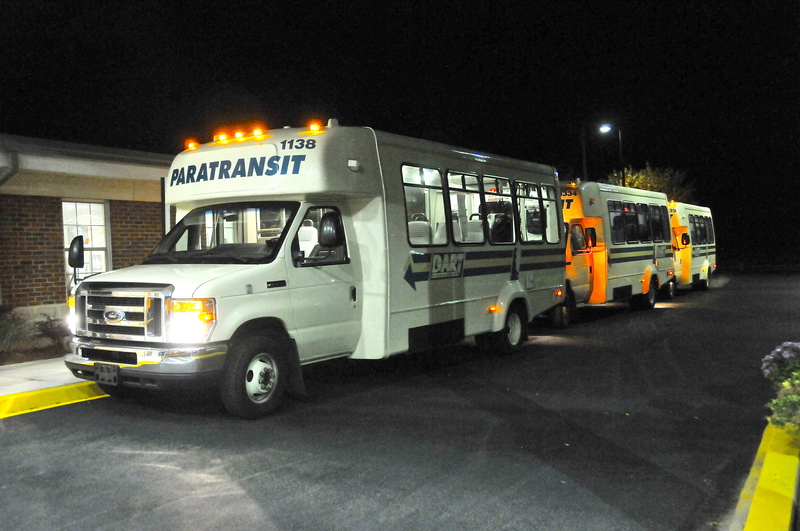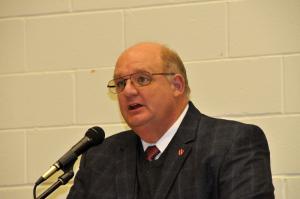Public transportation in Sussex County is changing – and proposals have county residents up in arms.
During a Nov. 5 public hearing at CHEER in Georgetown, state transportation officials heard from dozens of people who use the state's DART buses – some on a daily basis. What they heard is that the current system has problems that would only be exacerbated by proposed changes.
Officials say rate increases, route modifications and scheduling changes are necessary if the transit system is to be both effective and sustainable for years to come. It's the biggest proposed overhaul of the system since it began in 1977.
|
13,000 – Number of paratransit riders in the state. |
Changes include rate increases
Riders with disabilities are likely to see major changes. The federal Americans with Disabilities Act requires Delaware Department of Transportation to provide paratransit service within three-quarters of a mile of local fixed bus routes. Delaware has never followed that regulation; it has instead provided door-to-door paratransit service in all corners of the state.
But officials say paratransit accounts for 8 percent of ridership, but takes up more than 45 percent of DART's $80 million annual budget. Transportation officials say each paratransit ride cost an average of about $50.
Under proposed changes, DART would comply with regulations in the federal ADA law. Bus service would still be available to paratransit riders outside ADA zones, but they would pay three times as much in fares and be scheduled for rides using a priority system and as space is available.
Some said they will pay more for less service.
Ken Bock, CHEER deputy director, said the problem with the proposed system is that nearly 80 percent of paratransit bus riders in Sussex County live outside an ADA zone area under federal guidelines.
He said with only two fixed bus routes in Sussex County – compared to 14 in Kent and 44 in New Castle counties – 79 percent of the current paratransit riders would fall outside of an ADA zone, forcing riders to pay higher rates and obtain rides when space was available.
“If the ADA regulations were strictly applied, four out of five persons currently relying on DART paratransit may find themselves isolated in rural areas with no access to essential services in their communities,” Bock said. “Mobility is the lifeblood of rural residents.”
DelDOT spokesman Geoff Sundstrom said Sussex paratransit riders are under the mistaken impression they will not get rides to work if they live outside an ADA zone. “Nothing could be further from the truth,” he said. “The change will allow DART to prioritize trips, and the top two priorities are medical visits and work-related trips.”
He said under the current system, rides are scheduled on a first-come, first-served basis.
In addition, Sundstrom said, the new system will also allow trip schedulers to group bus riders.
The law also allows for a 60-minute window before or after a bus rider's requested time.
Rates for paratransit riders within the new ADA zone would increase from $2 – one way – to $3 on March 2, 2014, and then to $4 in March 2015.
Rates for riders outside the ADA zone would increase from $2 to $6 next year and $7 – one-way – in 2015.
Fixed route rates would also increase over the next two years under the DelDOT proposal.
The adoption of the ADA zone system is set to be implemented on March 2, 2014.
Dozens testify at Sussex hearing
The waiting line to speak during the Sussex County public hearing on the proposed changes was long, and it didn't take long for the tone of the testimony to take shape.
Rep. Dave Wilson, R-Bridgeville, said what works in New Castle County does not necessarily work in Sussex County. “It's too rural; we have been shortchanged for years,” he said. “DART needs to sharpen its pencil and make the money go further to provide service to people who need it.”
Rep. Harvey Kenton, R-Milford, agreed with Wilson. “One size does not fit all,” he said.
William McCafferty, who is visually impaired and has ridden DART buses for 20 years, was among the most vocal critics. “DART has failed its ridership in Sussex County and Kent County,” he said.
He said the addition of more fixed routes in Sussex would help ease the strain on the paratransit system. “It's the only way to get it done,” he said, adding he's at a loss to understand why transportation officials struggle with providing mass transit in a state as small as Delaware.
Patsy Brown, a DART rider who lost a leg in a crash, said more coordination is needed in scheduling paratransit buses to accommodate riders' work and appointment schedules.
Many people said they were totally dependent on the paratransit system and appreciated that transportation was available to them. People told stories of getting to work late, arriving two or more hours ahead of appointments and waiting two hours after appointments for buses to arrive to take them home.
Ken Paprcka, acting director of Delaware Transit Corp., said complaints arise from the system's inability to sustain itself. “We exceed capacity on a daily basis, which leads to longer waits for riders,” he said.
William Drake, whose son uses DART buses to get to work, said he doubts his son will be able to keep a job because of the 60-minute window for providing service.
That sentiment was expressed by many people during the hearing.
Drake said last week, the average time his son spent on a paratransit bus going to work – from Rehoboth Beach to Millsboro – was 72 minutes and the average time he spent riding home was 60 minutes with one ride that took more than 200 minutes.
Nancy Cordrey, a parent advocate, said the cost increase would severely affect her daughter. Living outside an ADA zone, she would have to pay $14 for a round trip each day to get to work. “This would be 35 percent of her pay,” she said. “And if rides are based on availability, how are people going to be able to keep their jobs?” she asked.
“Paratransit transportation is not just an option; it's the only option,” she said.
George Tribbitt, who worked for DART for 28 years, said those making the schedules for paratransit rides should be people who live in Sussex County and not Dover.
Beth Seeds, CHEER program director, listed several cases of problems with the current system. She said riders from the same towns coming to CHEER at the same time end up riding on separate buses when they could be on the same bus. She said they have been several instances of CHEER riders getting home three hours after they left the program.
“A lot of money is wasted,” she said.
Arlene Littleton, former CHEER director, said there is not a single right fit for transportation in Sussex County without establishing a partnership between the state, local and community transportation systems. “Door-to-door transportation has to be reliable and safe. It's the difference between independence and dependence,” she said.
And for the nearly 80 percent who will not be in an ADA zone, Littleton joined with others when she said, “Sussex County does not have a plan to handle 79 percent of people who will be abandoned.”
Use of system skyrockets over past decade
Use of the paratransit system has increased more than 230 percent since 2000, Paprcka said. Costs have risen from $15 million to $45 million over the past decade. “It's unsustainable. We can't control the growth of paratransit because by law we can't say no. The system was never designed to cover such a large area,” he said.
Delaware's costs are far above national averages. Across the country, about 70 percent of costs are spent on fixed-route systems and about 11 percent of costs are spent on paratransit systems. “We are approaching 50-50,” Paprcka said.
Because paratransit service consumes nearly half of DART's $100 million budget, possible expansion of fixed-route service is hampered, particularly in Sussex County. “Some riders could use fixed route buses if they were available,” Paprcka said.
DART has plans to contract taxis and even community service vans to supplement transportation at less cost than using buses. With the savings, Paprcka said, DART is planning two new fixed routes in Sussex County between Georgetown and Millsboro and Millsboro and Rehoboth Beach. The Lewes Transit Center is schedule to open in May 2015, and some seasonal routes could be offered throughout the year, Paprcka said.
Ballooning costs in the paratransit system have hampered route expansion, Paprcka said. “Sussex County needs more fixed routes and it has been made clear that any money saved will be put into more fixed routes in Sussex,” Paprcka said.
“But we can't do that if we don't change the way we do business,” said Ken Botts, chief administrative officer.
Paprcka said nonprioritized paratransit service to everyone in the state was never intended. “It happened, and no one has been able to pin down why. Once the service was started in Sussex County in the 1990s, it was difficult to suspend it. And no one anticipated the growth of use of the service.”
“Right now, we can't prioritize. No other state does this,” Paprcka said. “It's an expensive way to do business.”




















































